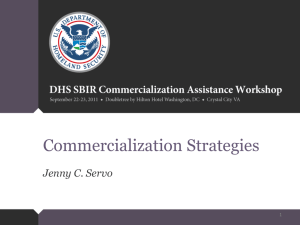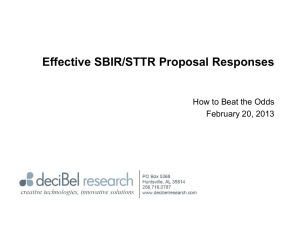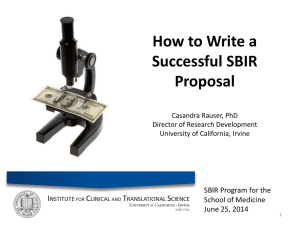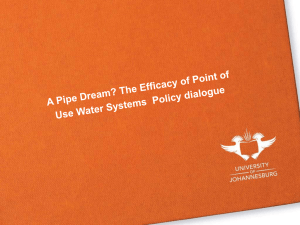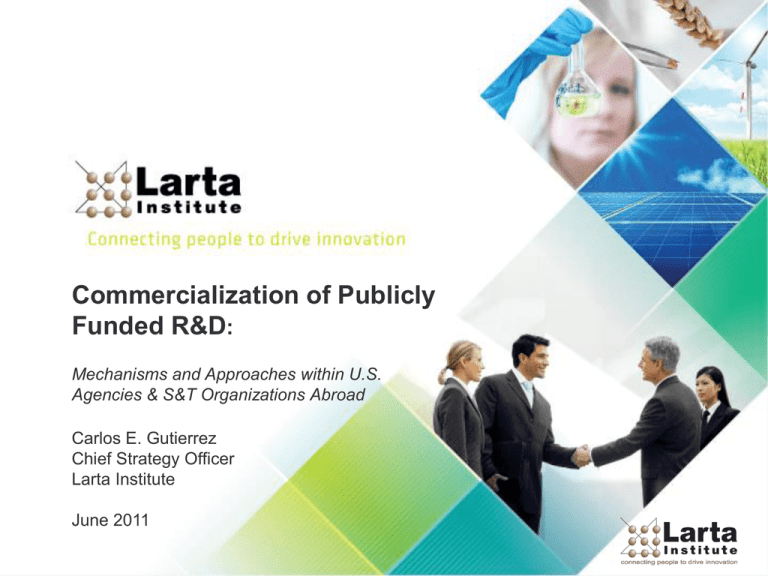
Commercialization of Publicly
Funded R&D:
Mechanisms and Approaches within U.S.
Agencies & S&T Organizations Abroad
Carlos E. Gutierrez
Chief Strategy Officer
Larta Institute
June 2011
Our Mission
To vastly improve the transition of
scientific and technological
breakthroughs from the lab to the
marketplace, and to help governmentfunded entrepreneurs/innovators create
self-sustainable enterprises
2
US and Global Clients/Partners
3
Confidential. Copyright Larta Institute 2011. All rights reserved
About Larta
Background
Core Services
• Founded 1993 as a public –private
partnership
• Non-profit, private corporation
• Innovation policy advice for both national and
regional economies around the world to build
strong ecosystems
• Design and execution of programs (for US and
Global Partners) to accelerate the market
readiness of early stage enterprises:
– Commercialization from emerging R&D-based enterprises
• Commercialization Assistance Programs (CAPs)
– University technology transfer
• Technology Transfer Programs (TTPs)
• Foster strategic relationships with capital
providers and industry partners
4
The US Experience - The SBIR & STTR Programs
Funding to Support R&D Activities
SBIR
STTR
•
Started in 1982
•
Started in 1992
•
All 11 agencies participate
•
The largest 5 agencies participate
•
2.5 % of agency R&D budget
•
Currently $2 Billion
•
$14 Billion Awarded via 50,000
grants since Inception
•
•
•
•
531 Publicly traded companies
Qualcomm, Millenium, Amgen, JDS
Uniphase etc.
1,200 M&A deals to date
552 current VC-funded companies
•
DOD, DOE, NIH, NASA & NSF
•
0.3 % of agency R&D budget
•
Currently $100 Million
•
Small business must have
partnership with non-profit research
institution
•
university or research center
5
A Three-Phase Program
Phase I: Start up Phase
• Grants $100K – $300K
• 6 – 12 months
• Support exploration of
technical merit or feasibility
Phase II: Expand idea, find
commercial outlets
• Grants from $500K - $3M
• 12 to 24 Months
• Refinement of technology
Phase III:
Commercialization
• No more government grants
• Private funding
• Exit: sales, IPO, licensing, etc.
6
The US Experience - The SBIR & STTR Programs
Mechanism to support commercialization of
publicly-funded R&D
Challenge:
• Agencies realized that they only provided support to one
piece of the equation (R&D work), but had no instrument to
facilitate the market readiness/awareness/connections for
innovations headed by a PI (principal investigator) with a
scientific/research background.
Solution:
• Agencies contract with external partner organizations to
design and implement Commercialization Assistance
Programs (CAPs) for their grantees.
7
Objective of Larta CAPs
Prepare tech-based enterprises to cross the Valley of Death
Larta mentors emerging companies, and connects them
to the right people, capital and resources.
8
Confidential. Copyright Larta Institute 2011. All rights reserved
Commercialization Assistance
Programs (CAPs)— A Virtual Model
Provide SBIR/STTR grantees with
focused assistance to refine their
business models, accelerate the
commercialization of their IP, and foster
connections with investors/partners
Larta designs and manages CAPs for 5 of the largest
SBIR/STTR programs of the federal agencies:
NIH, USDA, NSF, TATRC (US Army) and DOE
9
Larta U.S. CAPs
National Institutes of Health
•
•
•
80+ SBIR Phase II companies each year
Medical devices, pharmaceuticals, diagnostics, healthcare IT, biotech, etc.
18 months of tracking after the program
National Science Foundation
•
•
250+ SBIR/STTR Phase I companies each year
Industrial technology, cleantech, energy, advanced materials/nanotechnology,
electronics/IT, chemical-based technologies, etc.
US Department of Agriculture
•
•
40+ SBIR Phase II companies each year
Food and nutrition, precision agriculture, animal health, plant science, biofuels, etc.
US Army - TATRC
•
•
25 SBIR Phase II companies each year
Healthcare IT, Mobile Health, robotics, simulation software, etc.
US Department of Energy
•
•
125 SBIR Phase II grant applications reviewed each year, with recommendations
provided for funding grants
Energy efficiency, renewable energy, wind, solar, green materials, sensors,
generation, etc.
10
Confidential. Copyright Larta Institute 2011. All rights reserved
Anatomy of a CAP: NIH-CAP
Case Study
• Funded by NIH, developed and managed by Larta Institute to assist
SBIR Phase II NIH awardees with commercialization. Since 2004.
• Designed to help small life science and healthcare companies to
develop their commercial “profile” and transition their SBIR-funded
technologies into the marketplace
• Competitive process: 80 companies selected from among 250+ eligible
ventures
• The company’s “decision maker”/CEO is encouraged to participate in
the CAP as the CAP-Leader
• Sponsored (financed) by NIH.
• 10 month program (virtual and face-to-face).
• Combination of:
• Intense 1:1 mentoring by Larta Principal Advisor
• Feedback Sessions with external 3rd party experts (investors, industry, IP
strategists, regulatory specialists, etc.) – Boston, DC, Los Angeles
• Strategic Introductions through Larta Industry Advisory Boards (IAB)
11
Confidential. Copyright Larta Institute 2011. All rights reserved
Larta Industry Advisory Boards
(IAB)
Chemical/Materials/
Cleantech
Ashland Corp.
Electronics/IT/
Software
Boeing
BASF
Boeing
Honda Strategic
Venturing
Chisso Corp.
Dow Chemical Co.
Honda Strategic Venturing
Philips Healthcare
Sharp Corporation
Procter & Gamble
Sekisui Integrated
Research
TechNavi, LLC
SEMPRA Energy
Texas Instruments
Sharp Corporation
Texas Instruments
Schlumberger
Schlumberger
3M
Motorola
Life Science
Agriculture
Abbott
Allergan
Bayer
BD Ventures
Biogen IDEC
Boehringer Ingelheim
Genentech
Genzyme
Johnson & Johnson
Life Technologies
Medtronic
Merck
Novo Nordisk
Pfizer
Philips Health care
RCT Bioventures
Siemens Ventures
Takeda
Finistere Ventures
(Chair)
BASF
Bayer Crop Science
Cargill
ADM
Dow Agrosciences
Monsanto
Nelson Gibson (formerly
with John Deere)
Nestle
Novus International
Pioneer Hi-Bred
Syngenta
12
Confidential. Copyright Larta Institute 2011. All rights reserved
NIH-CAP Case Study
Deliverables
• The development of a Market-Driven Presentation. The presentation will
convey the company’s value proposition and will embody and address the
critical components of a market entry strategy: technology, Intellectual
property, markets and market need (problem), management,
manufacturing/business model and adoption issues, and strategic alliances.
• A 2-3-page Commercialization Strategy Report (CSR) document which
includes a Barriers to Commercialization document, a Competitive Matrix,
and a Commercialization Roadmap or schedule of budgetary and operating
milestones. The Commercialization Strategy Report will summarize
recommendations and next steps that will help the company meet the
commercialization objectives that were outlined earlier.
13
Confidential. Copyright Larta Institute 2011. All rights reserved
NIH-CAP 2010
Companies by Industry Sectors
Total
Biotechnology, 107, 16%
Other*, 124, 19%
Diagnostics, 86, 13%
Pharmaceuticals, 68, 11%
Healthcare IT, 90, 14%
Medical Device, 176, 27%
Biotechnology
Diagnostics
Healthcare IT
Medical Device
Pharmaceuticals
Other*
14
Confidential. Copyright Larta Institute 2011. All rights reserved
Metrics: NIH-CAP Case Study
•
Mentored over 600 NIH-funded
companies
•
$397 million raised by
companies attributable to Larta
impact*
•
10 acquisitions (8 companies, 2
technologies)
•
302 deals made
•
500+ initial proposals & term
sheets created
•
1,800 CDAs signed
•
3,600 meetings with investors &
partners arranged
NIH-CAP: 2004-Current
Additional Partnership &
Deal-Related Activity
* http://grants.nih.gov/grants/funding/cap/success_data_NIH_CAP.pdf
Confidential. Copyright Larta Institute 2011. All rights reserved
15
Larta - Global Bridge Initiatives
• Defined: CAPs designed for innovation agencies/S&T
organizations around the world
• Aligned with innovation policy objectives and integrated
with key stakeholders (universities/research institutes, industry,
economic development agencies)
• Focused on internationalization of early stage R&Dbased ventures and developing linkages to U.S. partners
• Strong component of technology transfer for benefit of
the regional partner
– Supports sustainability
– Builds local capacity for regions to manage their own commercialization efforts
– Linkage to Larta Institute as a ongoing U.S.-based partner
16
Confidential. Copyright Larta Institute 2011. All rights reserved
Carlos E. Gutierrez
Chief Strategy Officer
cgutierrez@larta.org
606 S. Olive Street, Suite 650
Los Angeles, CA 90014
ph: 213.538.1453
fx: 213.622.6230
www.larta.org
17
Confidential. Copyright Larta Institute 2011. All rights reserved



